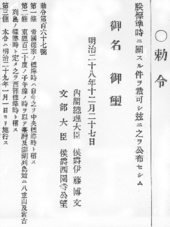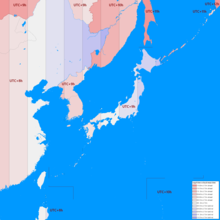| Japan Standard Time | |
|---|---|
| Time zone | |
| UTC offset | |
| JST | UTC+09:00 |
| Current time | |
| 19:16, 17 January 2025 JST | |
| Observance of DST | |
| DST is not observed in this time zone. | |
| Japan Standard Time | |||||
|---|---|---|---|---|---|
| Japanese name | |||||
| Kanji | 日本標準時 | ||||
| Kana | にほん ひょうじゅんじ にっぽん ひょうじゅんじ | ||||
| |||||

Japan Standard Time (日本標準時, Nihon Hyōjunji, JST), or Japan Central Standard Time (中央標準時, Chūō Hyōjunji, JCST), is the standard time zone in Japan, 9 hours ahead of UTC (UTC+09:00). Japan does not observe daylight saving time, though its introduction has been debated on several occasions. During World War II, the time zone was often referred to as Tokyo Standard Time.
Japan Standard Time is equivalent to Korean Standard Time, Pyongyang Time (North Korea), Eastern Indonesia Standard Time, East-Timorese Standard Time, Palau Time, and Yakutsk Time (Russia).
History
Before the Meiji era (1868–1912), each local region had its own time zone in which noon was when the sun was exactly at its culmination. As modern transportation methods, such as trains, were adopted, this practice became a source of confusion. For example, there is a difference of about 5 degrees longitude between Tokyo and Osaka and because of this, a train that departed from Tokyo would arrive at Osaka 20 minutes behind the time in Tokyo. In 1886, Ordinance 51 was issued in response to this problem, which stated:
Ordinance 51 (on the precise calculation of time using the Prime Meridian) – July 13, 1886
- The prime meridian passes through England's Greenwich Observatory.
- Longitudes are calculated using the prime meridian, counting 180 degrees either east or west. Positive degrees are east, negative degrees are west.
- On January 1, 1888, 135 degrees east longitude will be set as the standard meridian for all of Japan, allowing precise times to be fixed.

According to this, the standard time (標準時, hyōjunji) was set 9 hours ahead of GMT (UTC had not been established yet). In the ordinance, the first clause mentions GMT, the second defines east longitude and west longitude and the third says the standard time zone would be in effect from 1888. The city of Akashi in Hyōgo Prefecture is located exactly on 135 degrees east longitude and subsequently became known as Toki no machi (Town of Time).
With the annexation of Taiwan in 1895, Ordinance 167 (pictured on the right) was issued to rename the previous Standard Time to Central Standard Time (中央標準時, Chūō Hyōjunji) and establish a new Western Standard Time (西部標準時, Seibu Hyōjunji) at 120° longitude as the time zone for the Japanese Miyako and Yaeyama Islands, as well as Taiwan and its Penghu Islands. While Korea came under Japanese rule in 1910, Korea Standard Time of GMT+08:30 continued to be used until 1912, when it was changed to Central Standard Time.
Western Standard Time, which was used in Taiwan and some parts of Okinawa, was abolished by Ordinance 529 in 1937 and replaced by Central Standard Time in those areas. Territories occupied by Japan during World War II, including Singapore and Malaya, adopted Japan Standard Time for the duration of their occupation, but reverted after Japan's surrender.
Between 1948 and 1951 occupied Japan observed daylight saving time (DST) from the first Saturday in May at 24:00 to the second Saturday in September at 24:00 (with the exception of 1949, when the spring forward transition was the first Saturday in April at 24:00). More recently there have been efforts to restore daylight saving time in Japan but these have not succeeded.
In May 2013, former Tokyo governor Naoki Inose proposed permanently moving the country's time zone ahead by 2 hours to better align global markets and make Japan's stock market to be the first to open in the world at any given time.
Time zones of the Japanese Empire
The two-time-zone system was implemented in Japan between January 1896 and September 1937:
| Time offset | Name | Japanese | Romanization | Region |
|---|---|---|---|---|
| GMT+08:00 | Western Standard Time | 西部標準時 | Seibu Hyōjunji | Western Okinawa and Taiwan (see also Time in Taiwan) |
| GMT+09:00 | Central Standard Time | 中央標準時 | Chūō Hyōjunji | Japan mainland and Korea (see also Korea Standard Time) |
From October 1937, Central Standard Time was also used in western Okinawa and Taiwan.
IANA time zone database
The IANA time zone database contains one zone for Japan in the file zone.tab, named Asia/Tokyo.
Daylight saving time in Japan

From 1948 to 1952, Japan observed daylight saving time (DST) between May and September every year. The United States imposed this policy as part of the Allied occupation of Japan. In 1952, three weeks before the occupation ended, the Japanese government, which had been granted increased powers, abolished daylight saving time, and the Allied occupation authorities did not interfere. Since then, DST has never been officially implemented nationwide in Japan.
Starting in the late 1990s, a movement to reinstate DST in Japan gained some popularity, aiming at saving energy and increasing recreational time. The Hokkaido region is particularly in favour of this movement because daylight starts as early as 03:30 (in standard time) there in summer due to its high latitude and its location near the eastern edge of the time zone, with much of the region's solar time actually closer to UTC+10:00. Because of this, the sun sets shortly after 19:00 in much of the eastern part of the country (in Tokyo, the latest sunset of the entire year is 19:01, from 26 June to 1 July, despite being at 35°41'N latitude). Since 2000, a few local governments and commerce departments have promoted unmandated hour-earlier work schedule experiments during the summer without officially resetting clocks.
The Council on Economic and Fiscal Policy of the Cabinet Office is expected to propose that the Japanese government begin studying DST in an attempt to help combat global warming. Japanese former Prime Minister Shinzō Abe made a significant effort to introduce daylight saving time, but was ultimately unsuccessful. However, it is not clear that DST would conserve energy in Japan. A 2007 simulation estimated that introducing DST to Japan would increase energy use in Osaka residences by 0.13%, with a 0.02% saving due to lighting more than outweighed by a 0.15% increase due to cooling costs; the simulation did not examine non-residential buildings.
Possibility of adjusting the time zone
On May 22, 2013, the Governor of Tokyo (then) Naoki Inose proposed a two-hour advance (UTC+11) Japan Standard Time at an industry competitiveness conference. Its purpose is to enhance the influence of the Japanese financial market by starting early in the Tokyo financial market. The Japanese government has decided to consider this proposal. However, there has been no specific discussion of this proposal for more than ten years.
See also
References
- Time and Date (13 September 2020). "Current Local Time in Japan". Retrieved 12 September 2020. There is a difference between GMT and UTC which can be as much as 0.9 seconds. Japan now legally uses an atomic clock synchronized to UTC.
-
明治十九年勅令第五十一号(本初子午線経度計算方及標準時ノ件)
(明治十九年七月十三日勅令第五十一号)
- 英国グリニツチ天文台子午儀ノ中心ヲ経過スル子午線ヲ以テ経度ノ本初子午線トス
- 経度ハ本初子午線ヨリ起算シ東西各百八十度ニ至リ東経ヲ正トシ西経ヲ負トス
- 明治二十一年一月一日ヨリ東経百三十五度ノ子午線ノ時ヲ以テ本邦一般ノ標準時ト定ム
- 明治二十八年勅令第百六十七號(標準時ニ關スル件) - Wikisource
- 昭和十二年勅令第五百二十九號(明治二十八年勅令第百六十七號標準時ニ關スル件中改正ノ件) - Wikisource
- 昭和二十三年法律第二十九号(夏時刻法) - Wikisource
- "Outline of the report on the National Conference on the Global Environment and Summer Time". The Energy Conservation Center, Japan. September 1998. Archived from the original on 2007-04-09. Retrieved 2007-04-14.
- Hongo, Jun, "Daylight saving: Is it finally time to convert?", Japan Times, 28 June 2011, p. 3.
- Preston Phro (24 May 2013). "Gov't considers setting clock ahead by two hours". Japan Today. Retrieved 24 June 2020.
- Schreiber, Mark (28 April 2002). "Japan's 'long-awaited spring'". Japan Times. Tokyo. Retrieved 13 September 2020.
- Hongo, Jun, "Daylight saving: Is it finally time to convert?", Japan Times, 28 June 2011, p. 3.
- Thousands in Japan Adopt "Daylight Saving" Plan
- "Panel to call for daylight saving time". Yomiuri Shimbun. 2007-06-02. Archived from the original on 2007-06-06. Retrieved 2007-06-02.
- Yoshiyuki Shimoda; Takahiro Asahia; Ayako Taniguchia; Minoru Mizuno (2007). "Evaluation of city-scale impact of residential energy conservation measures using the detailed end-use simulation model". Energy. 32 (9): 1617–1633. Bibcode:2007Ene....32.1617S. doi:10.1016/j.energy.2007.01.007.
- "日本の標準時「2時間早く」 都知事が提案、政府検討へ". 朝日新聞 (in Japanese). 2013-05-22. Archived from the original on 2013-05-22. Retrieved 2019-12-19.
External links
 Japanese Wikisource has original text related to this article: 明治十九年勅令第五十一号
Japanese Wikisource has original text related to this article: 明治十九年勅令第五十一号- What time is it in Japan? Understand Japanese Time